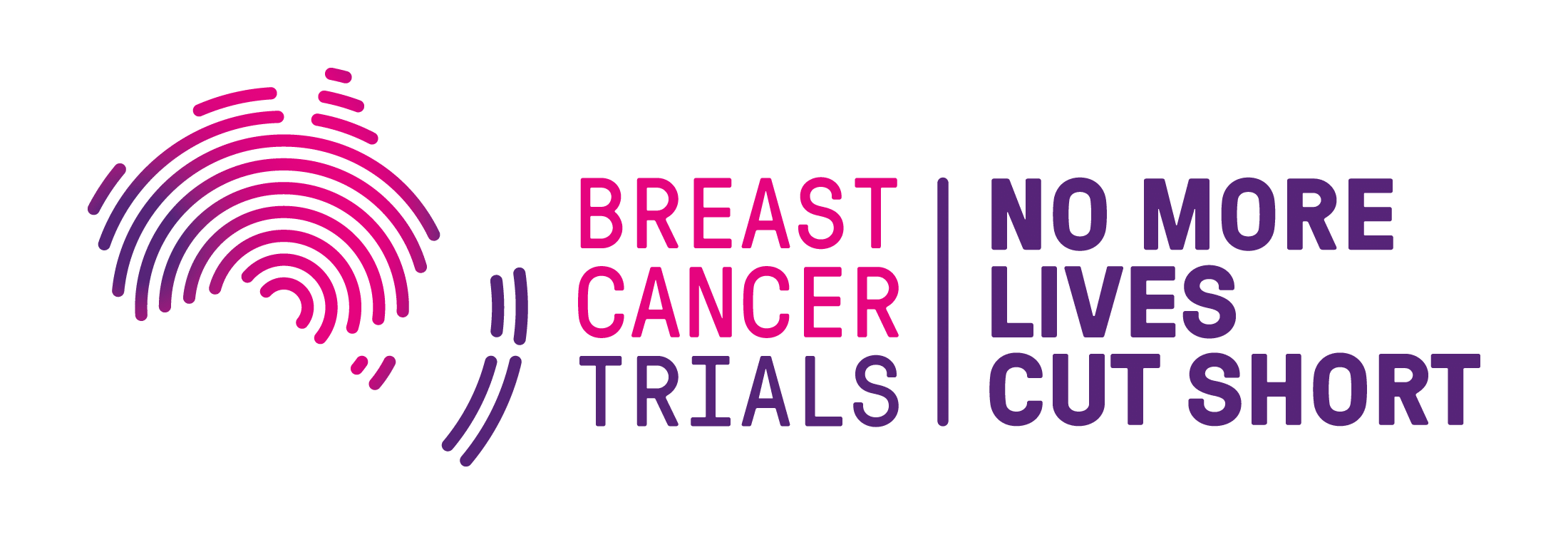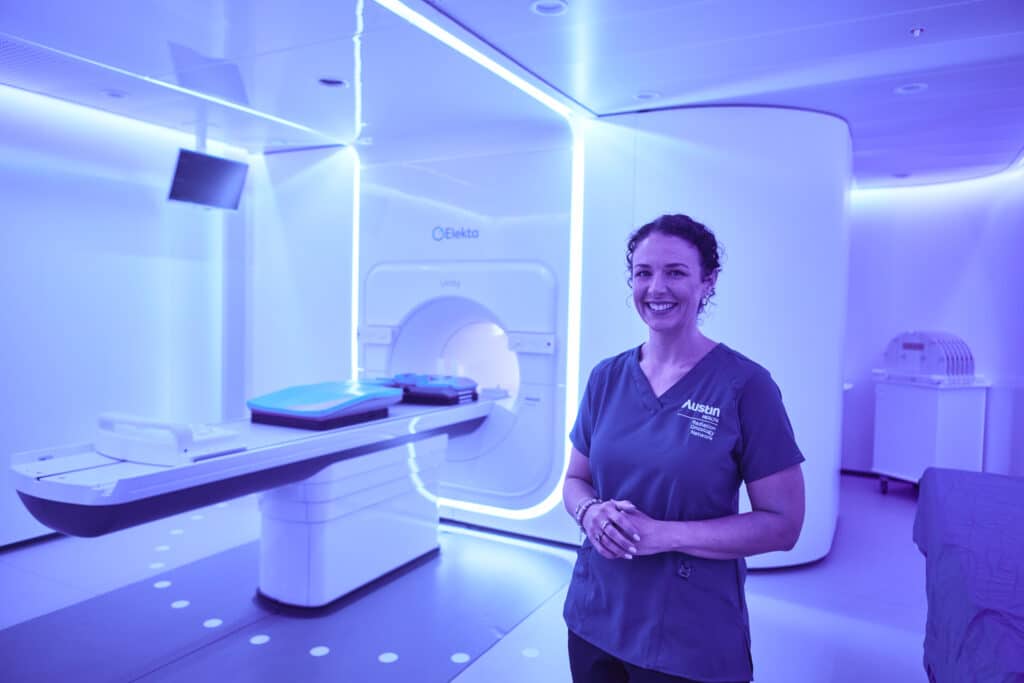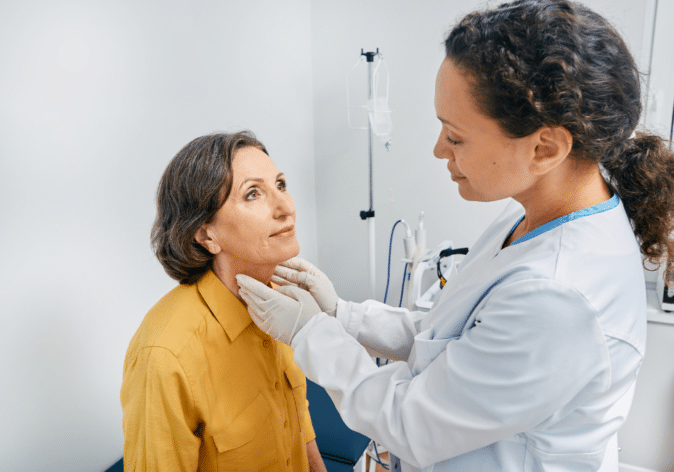Jenna Dean is a radiation therapist at the Olivia Newton-John Cancer Wellness and Research Centre with an interest in patient-centred care, research, breast planning, and particle therapy.
This is the third year of the Breast Cancer Trials Clinical Fellowship program and Jenna has been successful in receiving a fellowship in 2024.
Her project is called OPRAH MRL and will investigate the benefits and limitations of lying on your stomach versus lying on your back during treatment with the MR Linac, a magnetic resonance imaging system integrated with a radiotherapy treatment machine, to see which patients will benefit more from either treatment position.
We spoke with Jenna about her project and what she was hoping to achieve through this research.
“So, I’m working on my own research but I’m also helping my colleagues in our department to build their research capacity because a large part of what we do, particularly when it comes to improving what we do for our patients, comes from the research that we do within our department.”
“So it’s really important that we all know how to conduct research properly, that we understand why we’re doing it and what we’re setting out to achieve, but also that we learn a lot from it, so that when we get those outcomes from the research that we do, we can apply it in a safe way to make things better for our patients.”
“Early breast cancer is the most common presentation at cancer diagnosis in Australia. I think last year they were predicting around 20,000 Australian women would get diagnosed with early-stage breast cancer. For most of these patients, they can have a combination of treatments, but most commonly they’ll have a surgical procedure where they’ll have the lump removed and then they will have treatment with radiation therapy a few weeks later.”
“For a lot of patients there’s a lot of the unknowns. So certainly, before I got into the profession, I didn’t know what radiation therapy was, so there’s some uncertainty there. There’s a lack of information for people from credible sources, which I think is really important, and there’s a lot happening in that space to improve that scene.”
“For a lot of patients, to have a course of radiation therapy, you can be coming in for treatment for up to three weeks. So that’s three weeks where you’ve either got to juggle work, or kids, or school runs, or just being away from home, and not being able to work your usual hours, so there’s a lot to consider there, and it’s also just that it’s tiring to go in for lots and lots of appointments.”
“So, we know that for breast cancer patients, particularly early breast cancer patients, that it is safe and effective to treat them in five treatments instead of over three weeks. We know that we can treat the whole breast with a patient lying on their back or lying on their tummy. And the reasons that we do that is it changes some of the anatomy inside around a little bit by treating them on their back.
“For some patients that’s more comfortable, but for other patients, if we can treat them on their tummy, then we can change the position of the breast and move it away from things like your lung and heart and still get a high dose where we want it but minimize the dose to the other position.”
“Now, both positions are perfectly safe, and we do everything we can to limit the doses to the structures that we don’t want the dose to go to. But logically when you look at the anatomy, changing that position can change how we approach things.”
“So, what I’m setting out to do in this project is to set a lot of patients up in both positions and actually have a look at what the anatomy is doing and then see if we can identify patients that would be better in one position or the other without putting them through both scans.”
Listen to the Podcast
As part of Breast Cancer Trials Clinical Fellowship program, Jenna Dean is investigating the benefits of a prone vs supine treatment position with the MR Linac, a magnetic imaging machine.
What is Accelerated Partial Breast Irradiation?
“Accelerated partial breast irradiation, as it sort of implies, is delivering it faster. So that part of the treatment is that we deliver a bigger dose per treatment. So, for traditional radiotherapy, we will always deliver it over a number of doses. It’s a bit like a course of antibiotics. So, you take the whole course of treatment, and it builds up to the dose that we want as a total.”
“For the accelerated part, we’re going to give an equivalent dose, but we just give it in a smaller number of treatments, and we have a gap in between, so that the body still has a chance to recover and work the same way as it does with normal radiation.”
“For early breast cancer, we can treat the whole breast, or we can just treat part of the breast. And the reason that we’re moving closer towards treating part of the breast, is it then means that some of those longer-term side effects from treatment, like the cosmetic outcomes and some of the changes to your breast tissue are not as prevalent if we’re only treating part of the breast because the radiation only affects the area that it’s actually treating.”
“So, we do a faster course to a smaller area, and then in a shorter number of treatments. So traditionally you’d look at sort of 15 treatments over 3 weeks, but with the accelerated partial breast you’re looking at 5 treatments over a week or a week and a half.”
“With the way that the magnetic scanners work, the images are most precise in the middle. So when we set up a patient, because of the nature of the anatomy of the breast being sort of off to one side or the other, it’s not as close to the middle of that imaging field of view that we’d like to see, so where we look at the picture. So, because of that the changes in positions for these, like partial breast patients, could be affected by which position the patient is in.”
“So, if for example a woman is laying on her back, then the breast might fall out towards the side, and that moves it further away from that imaging centre. And in opposition to that, if we’ve got the patient on their tummy, hopefully that brings the breast closer to the middle of the imaging view. And it then hopefully it will result in fewer adjustment to that image.”
“Now, there’s lots of algorithms and fancy things we can do to the images to correct for this. But again, ideally, the more we can minimize it when we’re actually collecting the images, then the more assured we can be that we’re getting an accurate representation of what we’re looking at.”
What is the Difference between a Supine and Prone Position?
“So, in a supine position, the patient’s laying on their back with their arms up above their head, and fairly flat. But in the MR space, we also then need to use another part to take the picture, which means we’ve got a big panel that’s referred to as a coil that comes quite close to the patient’s face.”
“For some patients that can actually be quite confronting and a little bit scary. So, lying on your back, you’ve got arms supported, but it’s the best way for us to get access to treating that breast and not treating anything that we don’t want to treat. If we were to treat somebody prone, that’s putting them on their tummy. We’ve got a specially designed board that allows us to have the breast we’d like to treat sort of hanging in a space, so it moves down towards the treatment machine.”
“The other one’s sort of up and off to the side so it’s well and truly out of the road. And it’s a bit like lying on a massage table. You’ve got your face in a little hole so you can see there’s still air there, and again, you’ve got both arms up, but it’s kind of like you’re just sort of lying on a massage table with your arms up. But again, it just sort of flips all of your anatomy over.”
“So, my project is looking at the differences with that, as well as sort of the changes or potential changes to the image with the field of view and where the anatomy sits in that space. We also know that by treating part of the breast for some patients with their tumours, depending on which part of the breast it’s in, for some patients we hypothesize that it’s going to be better to have them treated on their tummy because having the breast moved away from the chest wall is going to help us get access to that tumour there.”
“But for other patients, if it’s up really high on the breast or really close to their middle, then that position can actually be quite challenging. So, the idea is to get each of the patients to lie in each position and see which one would be better for them based on where their tumour was because they’ve had surgery before they come to us, and then where it then sits in relation to their other anatomy.”
“So, we’re going to take lots of measurements and try to work out which position would be better, if a patient has a breast tumour for example towards their middle on one side, or out on the outside. Hopefully we can use that information to work out whether dose wise or comfort wise they would be better in either position.
“So, we do intend to ask everybody who participates in the study whether they preferred one position over the other, and also get them to let us know why. So again, we can sort of include their feedback because the board was developed so that we could actually set up this study. There wasn’t a version available prior to this. So, we’ve sort of based it on what we think and our clinical experience, but to also get some patients actually using the board and telling us what they like about it, telling us what could make it more comfortable.”
“So those original scans, we are sort of looking at 15 to 20 minutes in each position. The treatment takes a little bit longer because the beauty of treating them on the MR machine is we can take an MR picture. We can see exactly where everything is without giving them any radiation. We then have it set up in our system that we can see what’s changed, and if we need to, we can make some adjustments to the treatment plan before we deliver their treatment on the day.”
“I think it’s a really important aspect of this because the more we can make treatment better for them, the nicer we can make a less pleasant experience at times. So, for treatment, it’s usually a bit longer if we treat them on the MRI machine, but it’s up to about half an hour, depending on how we go.”
What are the Research Methods for this Project?
“So, this one’s a pilot study from our perspective. We want to see if it’s feasible and we can treat patients with the board because some of the studies in Europe had sort of suggested that treating patients in that position on their tummy wasn’t actually possible just because of the size limitations with the MR Linac.”
“We’re hoping to show that we can actually deliver it that way and offer it to suitable patients that would benefit from it. We are hoping to accrue 30 patients, and we got our first patient a couple of weeks ago and we’ve got another couple in the works, so it’s exciting that we’re actually getting somewhere, and things are underway.”
“We’re hoping to prove that it is feasible to treat patients in either the supine or prone position on the MR Linac and we then want to use that towards some other studies that we’re looking at, because we wanted to make sure that we could treat patients with APBI safely and effectively on the MR Linac with a sort of standard treatment regime.”
“From there we can then use this knowledge to look at more novel techniques as it goes forward. So, looking at sort of some higher doses in less fractions, or higher doses in less treatments.”
How Important are Donations in Advancing Treatments and Scientific Knowledge?
“Donations are extremely important. I think we are all aware that unfortunately as much as we’d love to just be able to do research, there are costs involved. It involves time, you need equipment, you need people with specialist knowledge and skills, and nobody actually does any of this alone, so I think all of that in combination to be able to get the opportunities like this one are really important.”
“It now means that I have specific time that I can set aside to focus on working on this project. I think a lot of the other challenges in research are that people undertake things and then other work gets in the way or time gets away from you because they don’t have the time or the resources to translate what they’ve learned into some findings and then presenting and sharing that work. So having the platform and the opportunities to get in, to do the research, to actually follow it through and make sure that it happens and then share those outcomes is really important.”
Our life-saving breast cancer research is only possible thanks to the continued generosity of our supporters. Please help continue this vital work by making a donation today.
Support Us
Help us to change lives through breast cancer clinical trials research



